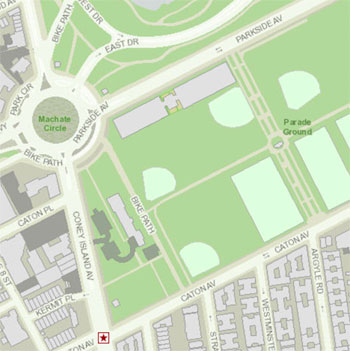Brooklynites are asking the city to stop penalizing people for walking and biking on a park path that lets them avoid dangerous traffic on a nearby street.

The paved path through the Parade Ground south of Prospect Park links the park loop with low-traffic neighborhood streets, serving as an alternative to Coney Island Avenue, a wide street with four lanes of through traffic. In particular, the path allows people to avoid the intersection of Coney Island Avenue and Caton Avenue, where drivers injured an average of two pedestrians or cyclists per year between 1995 and 2009, according to Transportation Alternatives' CrashStat. The path is also a designated bikeway on the New York City bike map.
It's common for people to use the path at night, and over the summer, local residents asked the 70th Precinct to stop issuing criminal court summonses on the path after sunset.
At a September meeting of the 70th Precinct community council, Deputy Inspector Richard DiBlasio said NYPD was issuing summonses for the safety of people walking and biking, reported Ditmas Park Corner. "Unfortunately, there’s been some recent crime in that area -- there’s been an increase in crime in that area," said DiBlasio. "We don’t want to prevent anyone from using our park, but when it gets dark in that park there are different rules because it’s not safe." The Prospect Park Alliance posted new signs emphasizing that the path closes at night.
But people who use the park path are more concerned about traffic on Coney Island Avenue than traveling through the Parade Ground after dark.
"Many are coming and going to Prospect Park while others are walking home from the F train," wrote local resident Olgierd Bilanow on a petition asking the Prospect Park Alliance and the city to change the rules and keep the path open until 1 a.m. "For all these people walking through the Parade Ground path is the easiest, safest and most pleasant way to go between home and Park Circle."
On Tuesday, Bilanow posted an update: "The 70th Precinct has vetoed any changes to the hours at the Parade Grounds."





